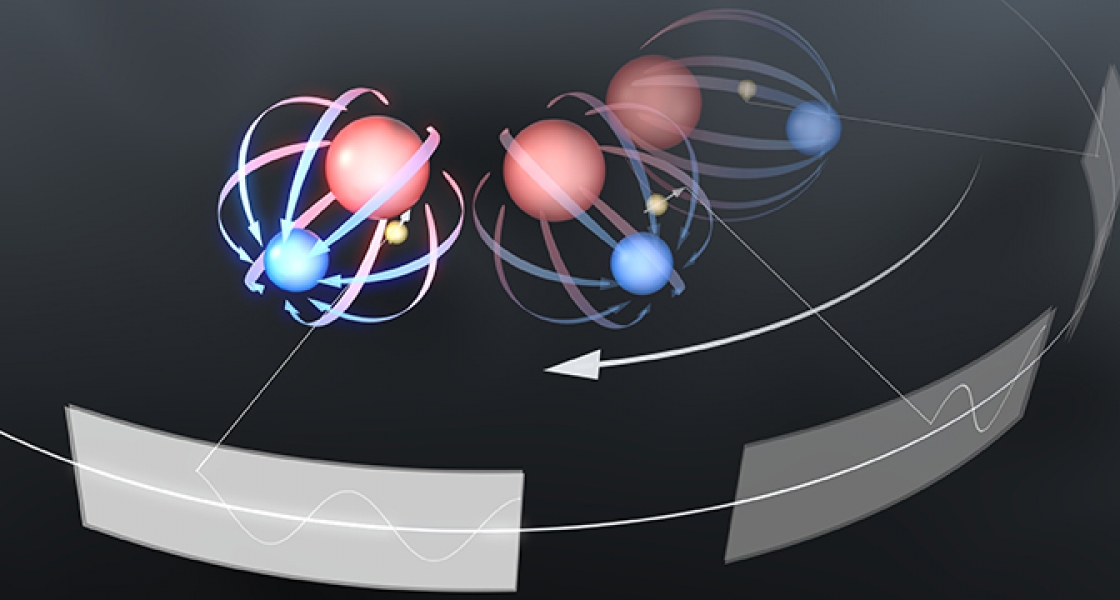Physicists wonder about some pretty strange things. For instance, one burning question is: How round is the electron? While the simplest picture of the electron is a perfect sphere, it is possible that it is instead shaped like an egg. The egg shape would look a bit like a tiny separation of positive and negative charges. Physicists call this kind of charge separation an electric dipole moment, or EDM. The existence of an EDM in the electron or any other subatomic particle will have a profound impact on our understanding of the fundamental laws of physics.
The Cornell and Ye groups are investigating whether the electron has an EDM—with the goal of either providing an extremely tight upper bound for its value or actually measuring it. They’ve been working on this problem for nearly a decade because knowing the size of the electron’s EDM (eEDM) may help scientists better understand how the world works, including why there’s enough matter in the Universe to form galaxies, stars, and planets like our Earth.
Right now, there are several different theoretical models of fundamental particles (such as the electron) and their interactions that attempt to explain how the Universe came to be. Each one predicts a different value for the eEDM. The values range from a charge separation of 10-25 to -40 cm. To put these numbers in perspective, a charge separation of 10-25 cm would correspond to an out-of-roundness for a spherical Earth of 2.2 microns (10-6 cm), which is roughly the size of a small bacterium. The current published eEDM limit is 10-27 cm, which corresponds to an Earth out-of-roundness of .022 microns, or the size of a small virus.
So, if there is an eEDM, it is a pretty darn small one. For starters, an electron with a diameter of ~3 x 10-13 cm is whole a lot smaller than the Earth with a diameter of 1,300,000,000 cm. The small size of the electron makes it technically very challenging for researchers to pinpoint and measure the much, much smaller eEDM. Fortunately, the Cornell and Ye groups (with help from the Bohn theory group) have invented a nifty new approach to zeroing in on this important measurement.
The new approach comes compliments of recently minted Ph.D Huanqian Loh, graduate students Kevin Cossel and Matt Grau, former postdoc and graduate student Kang-Kuen Ni (now at Harvard), former graduate student Ed Meyer (now at Kansas State), and Fellows John Bohn, Jun Ye, and Eric Cornell.
The experiment uses a trapped ball of ~1000 ions of hafnium fluoride ions (HfF+), which Meyer and Bohn originally identified as ideal for an eEDM experiment. Recently, the researchers took the ions and aligned them with an electric field that rotated in time. This procedure caused the axes of all the molecular ions to point in the same direction while still keeping them in the trap. This important step allows the researchers to probe the interaction of an electron inside an ion with large electric fields already present inside the HfF+ ions.
The idea is that identically aligned electrons in all 1000 ions will help to magnify an eEDM signal (if there is one). And, because the ions can be trapped for a long time, the signal can be measured for much longer than in other experiments in neutral molecules. The new apparatus represents a major advance in the technology for precision measurement of an eEDM.
Cossel and his colleagues are now working on improving their apparatus in anticipation of looking for an eEDM at the level of 10-28 or 10-29 cm, a level that is predicted by at least one major theory. Measuring at this level tests some of the same physics under study at the Large Hadron Collider in CERN, Switzerland. Never a dull moment!—Julie Phillips




